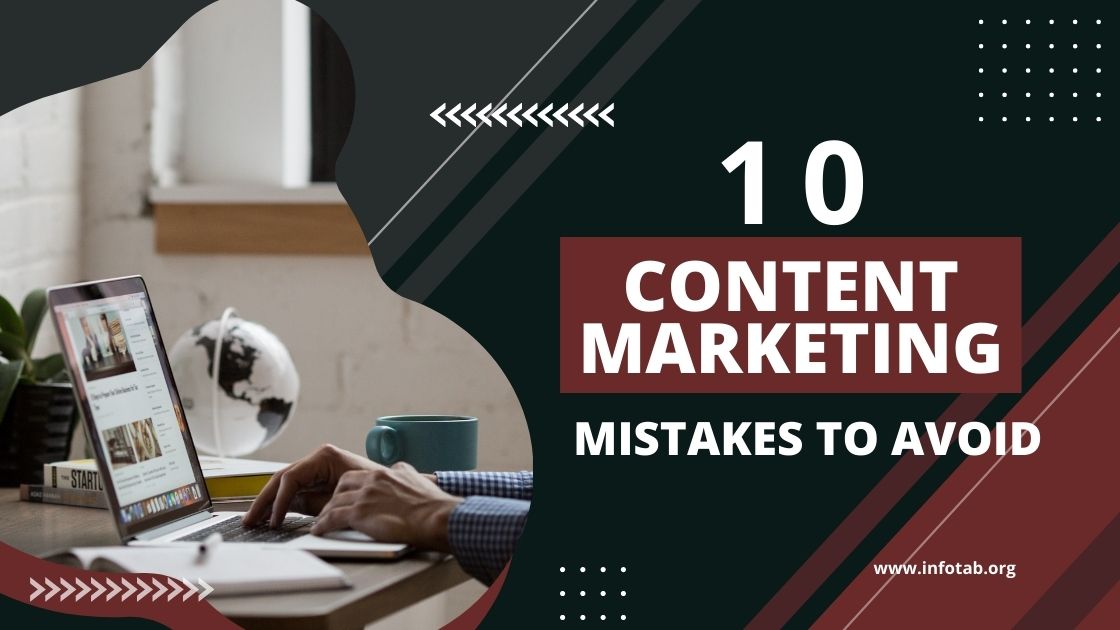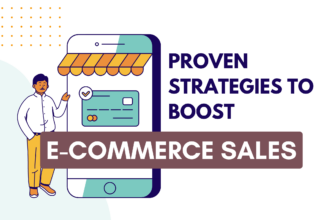
If you want to improve your content marketing campaign, then you might want to take a closer look at this list. First, why should you want to improve your content marketing?
60% of marketers report that content marketing generates demand/leads. In addition, 70% of marketers say that content marketing helps to educate the audience, and 60% say that it helps build loyalty with existing clients/customers (CMI).
Now that you know the importance of content marketing, let’s get started!
1. Not Having Clear Goals
Having a clear goal for content marketing is one of the most important aspects of creating content. Without a plan, you may create content that no one wants to read, which isn’t as effective as creating content that helps your audience achieve their goals.
Your business needs a clearly defined goal and you need to create content that your audience wants to consume.
For example, if you’re a clothing brand and want to reach customers looking for brands and styles they can use with their existing clothing line, you could create an article about how to combine different styles or what types of clothing work well together.
When starting, it’s important not to get too caught up in the buzz of content creation. Rather than focusing on how many posts you’ll need to create or what new topics you’ll cover each month, focus on one goal at a time.
By having clear goals for your content marketing strategy, you’ll be able to see where it fits concerning other marketing efforts (such as paid advertising campaigns) and make sure that it has a high ROI potential.
2. Not Having a Content Strategy
You can’t just sit down one day and start writing content for your website. You need a plan first.
That means knowing what you want to accomplish with your website. Want to increase brand awareness? Want to improve conversion rates? Depending on your goals, your content strategy will be different.
After defining what your brand wants to achieve, you can start developing an editorial calendar that outlines when you’ll publish new content on your site.
A content strategy is like a roadmap for your company, outlining exactly what you want to do, where you’re going, and how you will get there.
It should answer the question: What is our purpose for writing? How will we accomplish that? And why?
Without a clear focus on what makes good content, it’s easy to fall into the trap of producing whatever comes out of your head – and that can lead to some pretty bad results.
You also need to know who your target audience is so you can tailor your content accordingly.
For example, if you sell clothes for women ages 25-to-35, then all your blog posts should address this age range. You’ll not write about clothes for women in their 60s or about clothes for men.
3. Creating Low-Quality Content
The most common mistake made by businesses is creating low-quality content. Low-quality content doesn’t provide value to your potential audience. Badly written, irrelevant, or duplicate articles will only lead to a poor user experience and lost revenue opportunities.
If you want to succeed with content marketing, you need to write about topics related to your business that other people find useful or interesting. Make sure that what you write about relates specifically to what you do as a business owner or entrepreneur.
A good tip is to take time out of each day to read other blogs or websites from different industries worldwide so that you can stay up on new trends in the industry and how other businesses are doing things differently than yours. Creating low-quality content can hurt your business in many ways:
- It will make it harder to rank on search engines like Google and Bing because Google penalizes sites that use low-quality content.
- It will decrease your brand awareness and trustworthiness with customers because they will see it as a sign of poor quality from the get-go.
- It will reduce the amount of engagement you get from your readers and followers, which means less traffic for your site and fewer potential customers for your business.
4. Not Understanding Your Target Audience
It’s not enough to know who you are and what your business does. You also need to understand your target audience and why they should care about your product or service.
In addition to understanding your target audience, it’s also important for content marketers to create content that appeals directly to them. You should avoid writing blog posts about topics that don’t interest your potential customers or aren’t relevant to what they do in their daily lives – unless those topics are truly important to them.
5. Not Measuring Results
The most important aspect of your content marketing is to measure the results. How will you know if your efforts are successful if you don’t count the results?
There are a lot of different ways to do this. You can see how many subscribers you’re getting to your email list, how much engagement your posts get, and even how your strategy is impacting the revenue of the company.
A good tip to measure your content marketing results is by conducting a survey. Ask the people who have been exposed to the content and ask them what they liked about it. You can also ask them whether they would recommend it to others.
You can also conduct user research by asking potential customers about their experience with your product or service. You can interview people who have been using your product or service and ask them what they like about it or what they think could be improved in future versions of your product or service.
6. Focusing On Quantity, Not Quality
Focusing on quantity over quality will not get you anywhere.
Quality content is what separates you from your competitors. And it’s not just the quality of articles or blog posts that makes a difference, but also the quality of the writing. The more time you spend on your report, the better your content will be.
So, never settle for mediocre articles or blog posts.
To produce quality content, you must invest time and effort in research, writing, and editing. This can be tough when you’re already dealing with a busy schedule – plus, other things take priority over writing articles for your site. But if you want to rank high in search engines, you must focus on producing high-quality content for your site.
7. Not Promoting Your Content
One of the most important marketing elements to consider is promoting your content. Content promotion can take many forms, from social media posts and retweets to banner ads and email marketing. Here are some tips for promoting your content
- Paid advertising. Paid advertising can effectively drive traffic to your site, but it can also come at a high cost. If you want results fast and are looking for a way to reach more people, paid advertising might be right for you. If you want to learn more about paid advertising, you should check out this Super Affiliate System Review.
- Social media outreach. Social media outreach is another great way to promote your content but requires time and effort. The best approach is usually to use social media as an engagement tool. When someone shares something from your site on Twitter or Facebook, take the opportunity to engage with them by sending a message so that they know their sharing was appreciated.
- Referral marketing programs. Referral marketing programs allow businesses to attract new customers by offering incentives for people who refer new customers to their brand. For example, if someone signs up for your email list through a referral program, you’ll send them an exclusive discount code so they can save money on their next purchase from your store (or website). If you want to learn more about referral marketing, click here.
8. Not Being Mobile-Friendly
One of the biggest mistakes that many businesses make is not being mobile-friendly. Regarding content marketing, mobile traffic will continue to be one of the fastest-growing segments. Most people spend more time on their cell phones than on their desktops these days.
With this in mind, you must ensure that your website is designed for mobile users. However, if you’re not already taking advantage of responsive design (or even just having a responsive website), then there are still ways that you can improve your site’s mobile usability.
According to Yoast SEO:
“Responsive websites adjust their layout based on the size and viewing device they’re being viewed on.”
If someone accesses your site from their smartphone or tablet, they’ll see an optimized version of your site rather than something generic. You can also use responsive images instead of full-size images by uploading smaller versions into each post or page.
9. Ignoring SEO
Ignoring SEO is the biggest mistake content marketers make. Not only does it make your page rank less, but it also results in fewer clicks to your site.
Content marketing is a powerful tool for driving traffic and engagement, but if you don’t do your homework on SEO and keyword research, you’ll waste time and money chasing the wrong keywords.
If you’re not already doing some research on your keywords and how they’re performing in search results, you need to start now. Content marketing relies heavily on keywords.
Also, it’s important to not forget that there are many other ways to improve your SEO efforts – such as building links from authoritative sites that contain related keywords.
Once you’ve done that, start working on your content and making sure that every page contains relevant information to those keywords.
If you are not actively working on SEO, your content marketing efforts will fail. You need to understand why SEO works and how it can help you deliver more value to readers.
10. Outsourcing the Wrong Content Marketing Tasks
Content marketing is a complex, time-consuming process requiring much expertise. Creating quality content that will attract leads and customers takes time and effort. If you outsource the wrong parts of your content marketing, you’ll end up with a sub-par product that could cost you more than it should. Here are two things to keep in mind when outsourcing the work:
- You are outsourcing the writing of your blog posts and other content pieces. You can hire someone to write for you or do it yourself, but either way, you must know what works best for your business and how to deliver it in a way that will resonate with your target audience.
- You are outsourcing image creation or editing. You can hire someone to take care of this task or do it yourself, but either way, make sure that all of your images are aligned with your core values and brand identity, so they don’t look like they came from another company.
Wrapping Up
By avoiding these mistakes, you can ensure that your content marketing campaign will be an improvement over your previous efforts.
If you’re making these mistakes, don’t despair, you can still save your campaign with some diligent work. There are plenty of ways to recover from a mistake (or even a series of errors), so no matter what happens, you can still start fresh and create a great campaign.
Of course, always remember that every campaign is different. Your readers will respond to certain types of content better than others, meaning your copy should be fluid enough to accommodate both strengths and weaknesses. Keep this in mind while creating your campaigns, and you’ll find yourself well on the way to success.







